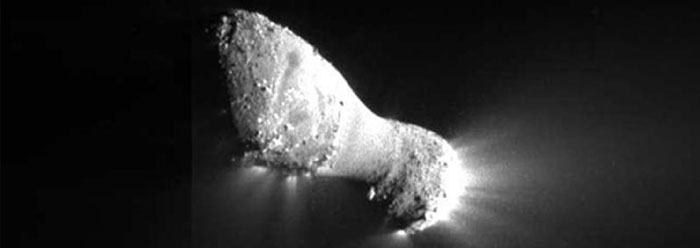Comets have fascinated their viewers throughout human history. Where did they come from? What are they made of? How did they start orbiting the sun? How old are they?
Modern technology is helping to provide some answers. NASA's EPOXI mission spacecraft obtained some close-up images of the comet Hartley 2, published this month on the NASA website.1 The comet was examined by scientists using equipment on the Deep Impact spacecraft, which investigated the Tempel 2 comet in 2005. Most of the spacecraft's fuel has been spent in its journey to intersect Hartley 2.
The "hyperactive, small, and feisty"2 comet was photographed from only 507 miles away. Jets actively outgassing CO2 were clearly visible. Combined with 2008 spectral data on Hartley 2 from the Spitzer Space Telescope, the new images were used by a team of astronomers to measure the effective size of the comet's nucleus, as well as the rate of its material loss.
Researchers already knew the orbital path and period for Hartley 2. After factoring in the loss of comet material due to outgassing jets, they wrote, "Barring a catastrophic breakup or major fragmentation event, the comet should be able to survive up to another 100 apparitions (~700 yr) at its current rate of mass loss."3
A comet's "apparition" occurs when it is visible from earth. Hartley 2 was visible in the Northern Hemisphere around midnight during the early weeks of November 2010. Its next apparition will occur in April 2017.
The data present a question. If the comet has a finite foreseeable lifespan, and if that lifespan is on the order of only hundreds of years, then why does the comet still exist as part of a solar system that is supposedly millions of years old?
Like other comets, Hartley 2 loses mass rapidly, especially when its orbit takes it close to the sun, where solar wind removes outer material. It loses even more material via its jets, which raises another question. Why does this comet still have energy left to push the gases out?
Given the standard evolutionary story of solar system beginnings, comets like this should be just the opposite of "feisty" by now. Instead, they should be lifeless, inert space rocks.
Therefore, the comet must be young. To try and fit young comets like Hartley 2 into a supposedly billions-of-years-old solar system, evolutionists came up with a comet-birthing area called the Oort Cloud. They insist that this "cloud" introduces new comets as the old ones burn out…though it has never been observed.4 Even if the Oort Cloud existed, the likelihood of a rock being displaced from it, by accidental collisions or otherwise, into a well-ordered orbital path around the sun instead of flying right through the solar system is fantastically small.
The short lifespan of comets, coupled with the fact that there is no observed natural source generating them, remains a thorn in the side of those who attempt to theorize about their origins based on a "billions of years" interpretation of history. When Hartley 2 flies by every seven or so years, its dwindling material and vigorous outgassing activity serve as reminders that the earth, solar system, and universe look young―just as the biblical record of a short earth history predicts.
References
- EPOXI: Encounter With Comet Hartley 2. NASA Mission Pages. Posted on nasa.gov November 4, 2010, accessed November 8, 2010.
- Black, S. NASA Deep Impact probe sends images of Hartley 2 comet from space. News.com.au. Posted on news.com.au November 5, 2010, accessed November 8, 2010.
- Lisse, C. M. et al. Spitzer Space Telescope Observations of the Nucleus of Comet 103P/Hartley 2. Publications of the Astronomical Society of the Pacific. 121 (883): 968-975.
- Morris, H. 1999. The Stardust Trail. Acts & Facts. 28 (1).
* Mr. Thomas is Science Writer at the Institute for Creation Research.
Image Credit: NASA/JPL-Caltech/UMD
Article posted on November 12, 2010.



















